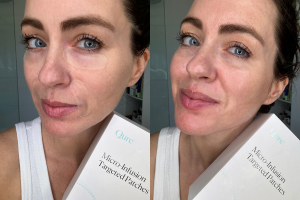5. Exercise for Better Circulation and Elasticity
Regular physical activity does more than just boost mood; it also helps your skin. “Exercise increases blood flow, delivering oxygen and nutrients to the skin,” says Joseph. Activities like yoga and strength training not only improve elasticity but also help reduce stress, which is a key factor in skin aging. The added bonus? Exercise also helps regulate hormone levels and boosts energy, which can make the perimenopausal transition smoother.
6. Address Hormonal Changes Early
Hormone replacement therapy (HRT) has often been misunderstood, but it’s crucial to discuss it as you approach menopause. Joseph emphasizes the importance of starting the conversation early: “It’s crucial to talk to your doctor about hormonal changes before menopause. Don’t wait until after to start managing your skin.”
Bioidentical hormones—plant-based hormones that are chemically identical to the ones produced by your body—have gained attention for being a safer option compared to synthetic hormones. HRT can help manage skin thinning, dryness, and other menopausal symptoms. However, it’s often overlooked because of previous concerns about links to breast cancer. Recent studies, however, have shown that when managed properly, bioidentical HRT is both safe and effective, offering benefits for both skin and overall well-being.
If you’re seeking natural alternatives to HRT, plant-based options like phytoestrogens (found in soy, flaxseed, and legumes) can help balance hormones naturally. Herbal supplements like black cohosh and evening primrose oil may also provide relief from menopausal symptoms, although their effects on the skin may be more subtle compared to HRT.
7. Prepare Your Skin Mentally and Emotionally
Menopause isn’t just a physical transition—it’s an emotional one too. “So many women experience depression or self-doubt when they start seeing changes in their skin,” says Joseph. “But if you know what’s coming, and you’ve prepared yourself, you can handle it with confidence.” Think of it like puberty—a tough but inevitable stage of life. Joseph adds, “We need to normalize it. Puberty is hard, but kids know it’s coming. Menopause is no different.”
8. Celebrate This Milestone
Finally, it’s important to celebrate menopause as a milestone. Joseph notes, “So many people don’t even make it to menopause. The fact that you’ve reached this stage is something to honor and celebrate.” It’s a reminder that aging is a privilege, and with the right preparation—both physical and mental—this next phase of life can be one filled with strength and confidence.
By following these steps and staying open to the changes ahead, Joseph says you can embrace perimenopause as a new beginning—stronger and more prepared for the journey ahead. We’ve got this! Our skin, and our spirit, are ready for this exciting next chapter.







